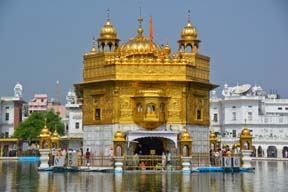Prosperous depository of national heritage & religions
 The city of Amritsar is a glittering showcase of compound traditions and secular culture. A thriving city with important devout centers and historical sites Amritsar exhibits a glorious past, magnificent present and a hopeful future. A significant city of Majha region, it has been entitled the prestigious title of the jewel of Punjab. A prosperous depository of national heritage and religion, it has been renowned as the abode of all merits.
The city of Amritsar is a glittering showcase of compound traditions and secular culture. A thriving city with important devout centers and historical sites Amritsar exhibits a glorious past, magnificent present and a hopeful future. A significant city of Majha region, it has been entitled the prestigious title of the jewel of Punjab. A prosperous depository of national heritage and religion, it has been renowned as the abode of all merits.
A synonym of Sikh religion, every pious Sikh desires to be hallowed with a pilgrimage to Amritsar and to have a divine bath at the Golden Temple. A visit to Amritsar is supposed to cleanse the soul of the pilgrim. An embodiment of Sikh belief, the core of Punjab’s political affairs, an opening to the Gulf countries, a watchful sentry at the Indo-Pak border, Amritsar adorns a remarkable position in the Indian subcontinent.
An icon of confrontation against the British despotism and the nucleus of Akali movements, Amritsar recalls the fierce onslaught of the Muslim invaders of the medieval India. Amritsar is like a lozenge with many features. The indispensable strength of the city lies in its effervescent monuments, sacred temples, pretty shrines and most of all in its folk arts and the tasty cuisine.
Blessed with a sociable and hospitable people, who are, reliable, casual, and jovial and have wonderful enthusiasm. They are fond of good cuisine, good dress and all the good amenities in life. Amritsar is not just an ordinary Indian city bestowed with tremendous attractions. It displays a stunning elegance and a lifestyle. In spite of its modern outlook, the city still preserves and emanates a vital and enriching uniqueness on their cheap tour packages in Amritsar.
Tourist Attractions
Golden Temple: The holiest abode of the Sikhs all over the world, the Golden Temple at Amristar is popularly called as the Sri Harmandir Sahib. The idea behind this sacred shrine was conceived by Guru Arjan Dev, who himself designed the structure of the temple. A Muslim saint Hazrat Mian Mir of Lahore laid the foundation of Golden Temple on 1st December,1588.
Placed on the lake, Amrit Sarovar, the Golden Temple, is bounded by a corridor of glittering white marble. Made up of the yellow metal, gold , this grand edifice of the Sikh religion is the pride of not only the Sikhs but also the entire nation.
, this grand edifice of the Sikh religion is the pride of not only the Sikhs but also the entire nation.
Akal Takht: Literally Akal Takht means Eternal Throne. It is considered as the one among the five sacred Takhts and has obtained the status of the power point of all religious activities of the Sikhs. Situated in the holiest premises of the Golden Temple, Akal Takht is conferred with the authority to call upon and order contrition on persons blamed with breach of sacred regulation.
Ber Baba Buddha: Sikh religion gave birth to so many pious and saintly people and Baba Buddha was one of such prominent figures, who adorn a remarkable position in the history of this sacred faith. It is believed that this sage was authorized with the construction of the Sarovar in the premises of the Golden temple. It is also believed that Baba Buddha used to sit under a tree, which is still preserved in the temple. This tree, which is called beri in the local language, is famed as the Ber Baba Buddha, which literally means the Baba Buddha’s tree.
Gurudwara Baba Atal: An octagonal tower with nine stories Gurudwara Baba Atal Sahib is a lofty structure with a height of 45 meters. This is believed to be the cremation ground of Baba Atal, who died at the tender age of nine. The nine floors of the building represent the short span of life of Baba Atal. A simple monument earlier, the present structure was the contribution of Maharaja Ranjit Singh.
Maharaja Ranjit Singh Museum: The summer palace of erstwhile king, Maharaja Ranjit Singh is now transformed into a wonderful Museum. It is surrounded by the lovely garden Ram Bagh. Maharaja Ranjit Singh is a prominent figure, who had carved a niche for himself in the history of India. The Museum displays objects connected with Maharaja Ranjit Singh; such as arms and amour, outstanding paintings and centuries old coins and manuscripts.
Most of the paintings on display showcase the court and camp of the king and among them, the most significant one is the painting of the city of Lahore with all its elegant structures. This legendary king of Punjab had shown a commendable spirit of secularism and it is reflected on the coins that are displayed in the Museum.
Wagah Border: The international borderline between India and Pakistan, Wagah is always in the news headlines of both countries. Convoluted buildings, barriers and roads mark both sides of the border. The fencing between the borders is electrified with very high voltage. The Swarna Jayanthi Gate, which is the entry gate of the outpost, commands the magnificent scenery of verdant landscapes.
Jallianwala Bagh: Jallianwala Bagh is a sprawling memory of the great tragedy, which evokes the patriotic spirit in every Indian. It was here, that the worst massacre in the entire history of Indian freedom struggle took place in the year 1919. To commemorate the murder of the innocent people a memorial was constructed at the site of the gruesome bump off.
Jalianwala Bagh is a vast garden spread over 6.5 acres and the most conspicuous structure in the garden is the memorial of the 1919 massacre victims. The memorial also preserves the portion of the wall with pellet marks along with the well.
Rambagh Gardens: An attractive garden, Ram Bagh is famed as the summer palace of the erstwhile Raja of Punjab, Ranjit Singh. This picturesque garden was formerly known as the Company Garden and its name was changed as Rambagh by Ranjit Singh to commemorate his faith and devotion to the great sage, Guru Ram Das. This garden is a prototype of Shalimar Garden of Lahore.
Bibeksar Sahib: Situated on the banks of Bibeksar Sarovar, this lovely Gurudwara was constructed by Maharaja Ranjit Singh. Bibeksar Sahib presents picturesque scenery and it lies between Sultanwind and Chativind. The Sarovar was dug by the 6th Sikh guru, Hargobind for devotees who wanted to be in sheer solitude. He used to sit by the sides of this Sarovar and united the Sikhs against the despotism of the Muslim rulers.
Durgiana Temple: The holy abode of goddess Durga in Amritsar, Durgiana temple resembles the Golden Temple in its structural design. It is considered one among the holiest temples in the city and dates back to the 16th century. Intricately carved paintings of goddess Durga in her various incarnations are the significant feature of this marvelous shrine. The peculiarity of this temple is that it does not follow the typical temple architecture of ancient times.
Khair-ud-Din Masjid: Built in the year 1876, this pretty shrine got tremendous impact in the freedom movement of India. This Masjid was built by Mohd. Khairuddin and it was from here the great call for waging war against the looting British were put forward by Tootie-e-Hind, Shah Attaullah Bukhari.
Amritsar has the extremes of summers and winters. The best time to visit the city is from October to March.
How to reach
By Train: Amritsar Railway Station is well linked to other rail heads in the state and is also connected to most of the cities in India. Direct trains are available from Delhi, Kolkata, Mumbai, and Bhopal.
By Air: Raja Sansi International Airport in Amritsar provides regular service to major Indian cities.
By Bus: State run public buses and private buses are available to move in and out from Amritsar. Grand Trunk Road connects Delhi to Amritsar.






